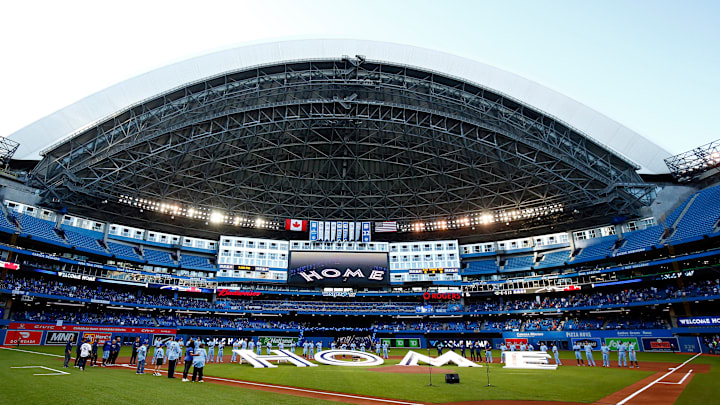Will hitters gain any advantage?
When the new outfield dimensions were leaked before the official announcement, there was plenty of excitement about a better offensive environment for hitters. But with the the reality of higher walls, we can temper our expectations.
Fortunately, with batted ball data like distance and launch angle we can get an idea of which Jays may benefit this season. Generally, the sweet spot for home runs is a 25-35 degree launch angle. We'll expand that range up to 45 degrees to capture fly balls from 2022 that would have had a chance to clear the new wall heights.
Let's start with newcomer Daulton Varsho. Per FanGraphs, he hit 168 fly balls, pulling 70, or 41.7%, of them to right field. Baseball Savant shows that the lefty had 32 hard-hit fly balls with a launch angle between 35 and 45 degrees.
His Statcast spray chart on Baseball Savant shows six or seven fly balls from last season that had the distance and launch angle to possibly end up as home runs instead of outs in his new home park.
Daulton Varsho's batted balls last season with 90+ EV and 25-45 deg. LA. There are 6-7 balls to RF and CF that were outs (one was a triple) that would likely be HR with the new Rogers Centre dimensions/wall heights. pic.twitter.com/LZiMGl8udy
— Michael Fisher 🇨🇦⚾️ (@FishyFisher82) January 29, 2023
The other new lefty addition, Brandon Belt, will enjoy Toronto after 12 years of hitting in Oracle Park, a notoriously challenging place to hit home runs. He doesn't pull the ball as frequently as Varsho, which the stadium may have influenced, but he has hit 50% fly balls over the past two seasons.
Belt's spray chart from the past two seasons demonstrates some avoidance of the spacious right-center power alley (415 feet!). It also shows several pulled fly balls swallowed up as outs, like this 407-foot moonshot that would easily clear the wall at Rogers Centre, even before the renovations.
Other notable hitters to watch
Bo Bichette, who has a well-known propensity for taking the ball to the opposite field, had two or three fly balls last season with enough distance and a high enough launch angle to clear the new right-field fence.
Matt Chapman hits his fair share of fly balls. He hit 48.5% last year and pulled a third of them. With an average launch angle of 19 degrees, he gets good loft and might have added two or three round-trippers.
Danny Jansen, a known pull hitter at 52.3% with a 50.6% fly ball rate, would have probably taken a couple more trips around the bases if the new dimensions were in play last season.
Vladimir Guerrero Jr. is an interesting case. Last season he hit over 50% ground balls and had an average launch angle of 4.3 degrees. With only 46 batted balls between 25-45 degrees, he still would have benefited with a couple more home runs if they had been hit in the new Rogers Centre.
The 2021 version of Vladdy, who hit 64 balls between 25-45 degrees and had a slightly higher launch angle, would have a better chance of capitalizing on the new field. But he'd still be limited by the higher walls because he also hits so many line drives.
While there's potential for additional home runs, the new wall heights will also take away home runs. But this doesn't necessarily mean less offense, just a different kind of offense than we are used to seeing in Toronto.
Home runs from previous years, those low-launch angle balls that barely cleared the fence, and shots down the line with just enough distance to get out will now stay in the park and potentially turn into doubles and triples, leading to extended rallies and more excitement on the basepaths.
Let's take a look at what this could mean for Blue Jays pitchers.
